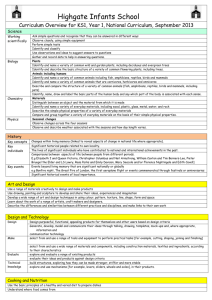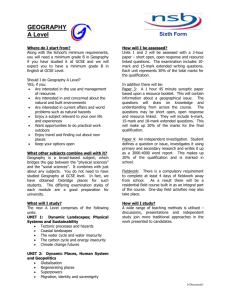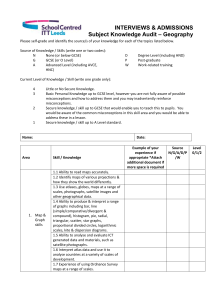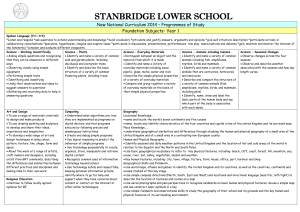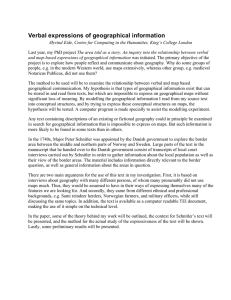Follow the new National Curriculum Curriculum Links
advertisement
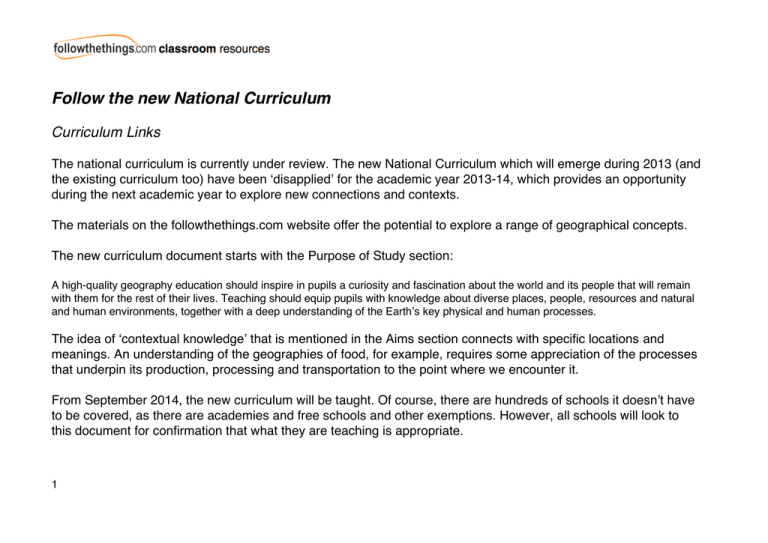
Follow the new National Curriculum Curriculum Links The national curriculum is currently under review. The new National Curriculum which will emerge during 2013 (and the existing curriculum too) have been ‘disapplied’ for the academic year 2013-14, which provides an opportunity during the next academic year to explore new connections and contexts. The materials on the followthethings.com website offer the potential to explore a range of geographical concepts. The new curriculum document starts with the Purpose of Study section: A high-quality geography education should inspire in pupils a curiosity and fascination about the world and its people that will remain with them for the rest of their lives. Teaching should equip pupils with knowledge about diverse places, people, resources and natural and human environments, together with a deep understanding of the Earth’s key physical and human processes. The idea of ‘contextual knowledge’ that is mentioned in the Aims section connects with specific locations and meanings. An understanding of the geographies of food, for example, requires some appreciation of the processes that underpin its production, processing and transportation to the point where we encounter it. From September 2014, the new curriculum will be taught. Of course, there are hundreds of schools it doesn’t have to be covered, as there are academies and free schools and other exemptions. However, all schools will look to this document for confirmation that what they are teaching is appropriate. 1 There are several useful opportunities to connect the work that is done in Key Stage 3 with the exemplars on the followthethings.com website. KS3 Draft Section of draft KS3 Pupils should consolidate and extend their knowledge of the world’s major countries. Relevant section of FTT website Use the Shipping section to explore connections between countries http://www.followthethings.com/shipping.shtml and map global trade routes Extend their locational knowledge and deepen their spatial awareness of the world’s countries using maps of the world… Use the Shipping section to explore connections between countries http://www.followthethings.com/shipping.shtml and map global trade routes …focus on Africa, South and East Asia (including India and China)… The followthethings.com bags were made in China – read their story and explore more about the Chinese link with clothing too: http://www.followthethings.com/shoppingbag.shtml and http://www.followthethings.com/whereamiwearing.shtml (Kelsey Timmerman’s book) Explore the connections between global trade and employment across the world. Connect with Gapminder to explore the changing nature of employment over time. http://www.gapminder.org and relate it to some of the products in our stores, such as the Simpsons couch gag: http://www.followthethings.com/simpsonscouchgag.shtml How does this connect with the changing nature of employment as a result of Globalisation, or the 2013 collapse of the Rana Plaza factory: http://www.followthethings.com/eternalembrace.shtml ? Human Geography related to… economic activity in the primary, secondary, tertiary and quaternary sectors… 2 Additional notes • Tracking items across the world offers scope for developing mapping and identification of countries. • There is also a section in the new document that specifically mentions Seas and Oceans – links to the idea of marine plastics and the followthethings.com shopping bag. • Tracking items across the world offers scope for developing mapping and identification of countries. How are these countries connected? What are the trade blocs and agreements that exist between them? • followthethings.com materials could help students identify some of the key locations where products are made within those countries: the use of maps and globes is specifically mentioned. • China and other countries are responsible for a growing proportion of the world’s ‘things’. Are they always produced in an ethical way? • How has China’s economic structure changed as a result of its switch to manufacturing from mostly agricultural employment within the last few decades. Explore some of the variables using Gapminder. • Use Urban Observatory to explore urban change: http://www.urbanobservatory.org/compare/index.html …the use of natural resources. Use Geographical Information Systems (GIS) to view, analyse and interpret places and data Use fieldwork to collect, analyse and draw conclusions from geographical data Explore issues of trade justice related to the exploitation of certain natural resources, such as our coins http://www.followthethings.com/commemorativecoin.shtml and fuel in our cars http://www.followthethings.com/theoilroad.shtml Some examples on followthethings.com use GPS to track the lives of things like milk - http://www.followthethings.com/milk.shtml - and shipping containers - http://www.followthethings.com/thebox.shtml Use GIS tools such as ArcGIS Online and its Story Map templates to plot some of the stories on the website. A collection of maps is here: http://storymaps.esri.com/home/ Use the followthethings.com challenger missions. Students should earn their Champion Shopper badges, and produce evidence for this: http://missionexplore.net/challenger/followthethings • Which natural resources are being exploited where to manufacture the items we buy and to get us and them to the store? • How sustainable is this process ? • Here’s an example map that could be connected with the Shipping section of our website: http://storymaps.esri.com/stories/2013/ports/ • Explore the real-world evidence for trade connections One obvious connection with a growing focus on locational knowledge is that all items are made somewhere. These places are changed by their involvement in the manufacturing of products and their connections with other aspects of the production chain. GCSE Subject content criteria As with the KS3 curriculum, there are also changes taking place to the GCSE Specifications. This sits alongside a general view that there needed to be some alterations to the way that students were assessed at GCSE, in the light of grade inflation over the last decade. The DfE has also released the new criteria for GCSE. The document emerged in June 2013. Awarding bodies will work with this document to produce a specification document that, after OFQUAL accreditation, will be passed to teachers to work with. 3 There are four main aims to the new document that will be fed through into the final GCSE specification that emerges. These documents will be subjected to OFQUAL inspection, and when they are accredited they will be sent to schools for first teaching in September 2015 (at the same time as new specifications for ‘A’ levels). GCSE specifications in geography should enable students to: • develop and extend their knowledge of locations, places, environments and processes, and of different scales and social, political and cultural contexts (know geographical material) • gain understanding of the interactions between people and environments, change in places and processes over space and time, and the interrelationship between geographical phenomena at different scales and in different contexts (think like a geographer) • develop and extend their competence in a range of skills including those used in fieldwork, in using maps and Geographical Information Systems (GIS) and in researching secondary evidence, including digital sources; and apply the cycle of collecting, presenting and analysing (geographical) data, including categorising and evaluating information and hypotheses (study like a geographer) • apply geographical knowledge, understanding, skills and approaches appropriately and creatively to real world contexts, including fieldwork, and to contemporary situations and issues; and develop well-evidenced geographical argument drawing on their knowledge and understanding. (understand the application of geography). There are possible connections with followthethings.com contained in most of the sections of the document. 4 Fieldwork There are opportunities for fieldwork when exploring the nature of commodities which are being studied with the help of followthethings.com. One area for potential study is to set one or more of the followthethings missions on the Mission:Explore website. The aisle of a supermarket could provide a fertile location for some investigation of sources, connections and controversies* using a trade justice smartphone app such as Buycott or the industry ratings on the website free2work.org. NB: any supermarket visit will need to be organised in advance with the supermarket. [*Margaret Roberts - who features in one of our Lego re-creations here - gave an excellent lecture on ‘Teaching Controversial Issues’ at the GA Conference in 2013. Download her lecture slides here] Co-operative supermarkets are, in my experience, more likely to be, er, co-operative and interested in connecting with local schools with regard to them accessing the store and using it for the basis of some fieldwork. They often have a slightly more ‘ethical’ sourcing, although you could explore that statement too. Geographical argument 'Geography is inherently values laden' (Roberts 2013). This is a specific section in the new document, and one that followthethings.com will certainly prepare you for. 5 A requirement for students to write descriptively, analytically and critically, to communicate their ideas effectively, to develop an extended written argument, and to draw well-evidenced and informed conclusions about geographical questions and issues. Argumentation requires the adoption of a position, or viewpoint that can be argued for and/or against. Students should not necessarily be arguing for something that they agree with. Each of the examples in the followthethings.com store offers the potential for work of this kind. Each page that features a film, artwork, activist campaign, or other source is designed to read like a discussion between the people who made, watched and took part in it that film, etc. Reading these pages, students can imagine themselves in these conversations, listening to many ‘sides’, experiences and points of view, making up their own minds on the issues being discussed, thinking what they might say… Using the website in this way, a more nuanced argument could be expected from students with respect to the ideas that underpin trade justice. Cities and Urban Society There are many connections again with followthethings.com. One of the most obvious has been the move of people from the rural areas of many countries to large megacities to work in factories. This is a very visible side to the process of globalization, and has resulted in many changes that are both social and environmental, as well as economic (the three legs of the sustainability ‘stool’). 6 Examples that clearly show these processes include two short documentary films from China about workers in a book factory and a battery factory, and a feature length ‘docu-drama’ about migrants who leave rural China to work in the food industry in Europe. Key Stage 5 There are also changes taking place with respect to ‘AS’ and ‘A2’ level qualifications. There will be new specifications from September 2015, which will also include separate courses for ‘AS’ and ‘A2’. These will be standalone courses, and students will not necessarily progress through the course in the same way that they have done in the past. The criteria for the production of these documents has not been released yet, but there have been discussions that have involved Higher Education establishments. The projects’ grounding in Higher Education work is likely to be an advantage when it comes to further developments at KS5. New materials will be added to the followthethings.com website as these documents emerge. Our team of newly qualified and experienced geography teachers (involved in our ♯followtheteachers project) will be reporting from their classrooms as they develop new materials throughout the KS1-5 curriculum using our website. Follow us on twitter @followthethings and/or check the hashtag ♯followtheteachers for updates. Alan Parkinson & Ian Cook Last updated July 2013 7
